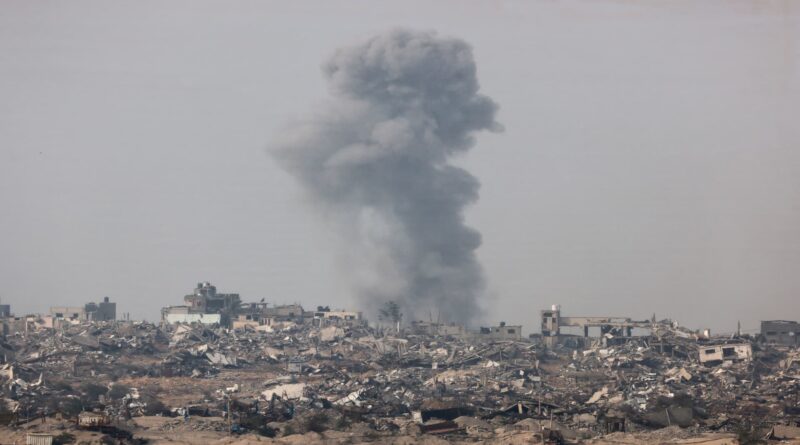New exodus causes havoc in central Gaza as Israel pushes advance
[ad_1]
Smoke rises over Gaza, amid the ongoing conflict between Israel and the Palestinian Islamist group Hamas, as seen from southern Israel, December 27, 2023.
Amir Cohen | Reuters
Tens of thousands of already displaced Palestinian families took flight again in a new mass exodus in central Gaza on Thursday, where Israeli forces mounting a major advance pounded areas already teeming with those driven out of the north.
Further south, Israeli forces struck the area around a hospital in the heart of Khan Younis, the Gaza Strip’s main southern city, where residents feared a new ground push into territory crowded with families made homeless in 12 weeks of war.
Israel has escalated its ground war in Gaza sharply since just before Christmas despite public pleas from its closest ally the United States to scale the campaign down in the closing weeks of the year.
The main focus of fighting is now in central areas south of the wetlands that bisect the Strip, where Israeli forces have ordered civilians out as their tanks advance.
Tens of thousands of people fleeing the huge Nusseirat, Bureij and Maghazi districts of central Gaza were heading south or west on Thursday into the already overwhelmed city of Deir al-Balah along the Mediterranean coast, crowding into hastily built camps of makeshift tents.
“Over 150,000 people – young children, women carrying babies, people with disabilities & the elderly – have nowhere to go,” the main U.N. organization operating in Gaza, UNRWA, said in a social media post decrying what it called “forced displacement” under Israeli evacuation orders.
The eastern part of Bureij was a theatre of heavy fighting on Thursday morning, with Israeli tanks pushing in from the north and east, residents and militants said.
“That moment has come, I wished it would never happen, but it seems displacement is a must,” said Omar, 60, who said he had been forced to move with at least 35 family members.
“We are now in a tent in Deir al-Balah because of this brutal Israeli war,” he told Reuters by phone, declining to give a second name for fear of reprisals. “Israel is killing doctors, social media influencers, journalists, and civilians.”
Yamen Hamad, living in a school in Deir al-Balah since fleeing from the north, said the new refugees arriving from Bureij and Nusseirat were setting up tents wherever there was open ground. Some had fled areas where Israel had warned them to go, others had come without waiting to be told.
With food running out, he said he had made a perilous trip to Rafah near the Egyptian border to buy a 25 kg sack of flour for his family.
Fighting near hospital in Khan Younis
Khan Younis, the main southern city where Israeli forces advanced this month after a truce collapse, came under heavy bombardment on Thursday morning from warplanes and tanks near the al-Amal hospital, west of Israeli positions.
The Palestinian Red Crescent, which runs the hospital and has its headquarters nearby, said 10 Palestinians were killed and 12 wounded in one bombardment there, the third strike targeting the area around the hospital in less than an hour.
Residents said they believed Israeli forces were trying to provoke a new exodus ahead of a further ground assault in the city. Al-Amal is not far from Nasser Hospital, the main hospital in Khan Younis and the largest still functioning in the enclave.
An Israeli tank fires towards Gaza, amid the ongoing conflict between Israel and the Palestinian Islamist group Hamas, at the Israel-Gaza border, in southern Israel, December 27, 2023.
Amir Cohen | Reuters
Palestinian officials reported 50 people killed in strikes in Khan Younis and in the central area. Israel reported three more of its soldiers killed in fighting in central and southern areas, bringing the toll in the ground campaign to 169. The past week has seen some of the heaviest losses of the war so far.
Israel says it will not halt its ground campaign in Gaza until it annihilates the Hamas movement, which controls the enclave. The war erupted when Hamas militants crossed the border and killed 1,200 people and captured 240 hostages on a rampage through Israeli towns on Oct. 7.
The Israeli assault has laid much of the enclave to waste. According to Palestinian authorities more than 21,000 people – nearly 1 percent of Gaza’s 2.3 million population – have been confirmed killed with thousands more dead feared lost in the ruins.
Virtually all residents have been driven from their homes at least once and many forced to flee several times. Only a handful of hospitals are still functioning.
Palestinians say wiping out Hamas, which has been sworn to Israel’s destruction for decades, is an unachievable aim given the militant group’s diffuse structure and deep roots in a territory it has ruled since 2007.
Israel says that since Oct. 7, the deadliest day in its history, it has no choice but war to safeguard its security and return more than 100 hostages still believed held by militants. It claims to have killed 8,000 fighters so far.
But its Western allies worry that the huge civilian casualties will radicalize a new generation of Palestinians and spread fighting to other areas across the Middle East. This week, Iran-backed groups have attacked U.S. forces in Iraq and commercial shipping in the Red Sea.
U.S. President Joe Biden warned this month that “indiscriminate bombing” jeopardized sympathy for Israel among its allies. Washington has publicly said Israel should make a transition from a full-scale ground war to a targeted campaign against Hamas leaders.
European countries that back Israel’s right to self-defense have taken this month to call for a sustainable ceasefire, a position French President Emmanuel Macron took on a phone call to Israeli Prime Minister Benjamin Netanyahu on Wednesday.
Since the war broke out in Gaza, fighting has also escalated on Israel’s border with Lebanon, and in the Israeli-occupied West Bank, where the U.N. said in a report on Thursday that human rights for Palestinians had sharply deteriorated.
[ad_2]




